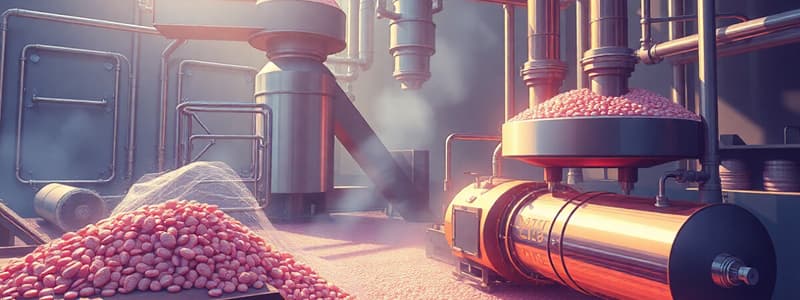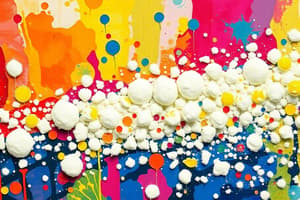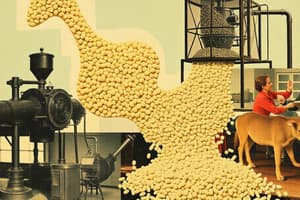Podcast
Questions and Answers
What is the primary purpose of granulation?
What is the primary purpose of granulation?
- To enhance color of the powders
- To increase powder density
- To decrease product size
- To prevent segregation of powder constituents (correct)
Granulation is used to create smaller, finer particles for tablet production.
Granulation is used to create smaller, finer particles for tablet production.
False (B)
What is the size range of granules used in tablet or capsule production?
What is the size range of granules used in tablet or capsule production?
0.2 - 4.0 mm
Granulation helps improve the _______ properties of powders.
Granulation helps improve the _______ properties of powders.
Which of the following does NOT improve due to granulation?
Which of the following does NOT improve due to granulation?
Name two reasons for performing granulation.
Name two reasons for performing granulation.
Match the following reasons for granulation with their benefits:
Match the following reasons for granulation with their benefits:
Granulation of slightly hygroscopic materials can help reduce the hazard of _______ powder adhesion.
Granulation of slightly hygroscopic materials can help reduce the hazard of _______ powder adhesion.
What is one advantage of granules over powders?
What is one advantage of granules over powders?
Granules are better suited for reconstitution than light and fluffy powders.
Granules are better suited for reconstitution than light and fluffy powders.
What is the main purpose of diluents in granulation?
What is the main purpose of diluents in granulation?
The first step in the wet granulation process involves ______ the powders by geometric dilution.
The first step in the wet granulation process involves ______ the powders by geometric dilution.
Match the following granulation methods with their characteristics:
Match the following granulation methods with their characteristics:
Which of the following is a disadvantage of using water as a granulating liquid?
Which of the following is a disadvantage of using water as a granulating liquid?
The granulating liquid can include organic solvents as long as they're non-toxic.
The granulating liquid can include organic solvents as long as they're non-toxic.
What is the function of binding agents in wet granulation?
What is the function of binding agents in wet granulation?
What is a key benefit of liquid bridges in wet granulation?
What is a key benefit of liquid bridges in wet granulation?
Over-drying during wet granulation can destroy solid bridges.
Over-drying during wet granulation can destroy solid bridges.
Name two types of bridges formed during the wet granulation process.
Name two types of bridges formed during the wet granulation process.
The process of powder particles aggregating under high pressure is known as __________.
The process of powder particles aggregating under high pressure is known as __________.
Match the types of liquid bridges to their characteristics:
Match the types of liquid bridges to their characteristics:
Which of the following is a potential problem in wet granulation?
Which of the following is a potential problem in wet granulation?
Solid bridges are formed during the drying phase of wet granulation.
Solid bridges are formed during the drying phase of wet granulation.
The dry granulation method is useful for drugs that are sensitive to __________.
The dry granulation method is useful for drugs that are sensitive to __________.
What is one advantage of dry granulation?
What is one advantage of dry granulation?
Electrostatic forces contribute significantly to the final strength of granules produced by dry granulation.
Electrostatic forces contribute significantly to the final strength of granules produced by dry granulation.
Name one component that is part of effervescent granules.
Name one component that is part of effervescent granules.
The _____ forces are about four times greater than electrostatic forces in dry granulation.
The _____ forces are about four times greater than electrostatic forces in dry granulation.
Match the particle-particle interaction with its description:
Match the particle-particle interaction with its description:
What is the primary reaction that occurs when effervescent salts are added to water?
What is the primary reaction that occurs when effervescent salts are added to water?
The melting of components in dry granulation significantly contributes to particle-particle interactions.
The melting of components in dry granulation significantly contributes to particle-particle interactions.
What effect do effervescent granules have on the taste of medicinal agents?
What effect do effervescent granules have on the taste of medicinal agents?
Flashcards
What is Granulation?
What is Granulation?
The process where primary powder particles join together to form larger, multi-particle units called granules.
What is the typical size range for granules?
What is the typical size range for granules?
Granules typically range from 0.2 to 4.0 millimeters in size. This size is ideal for producing tablets or capsules.
Are there different sizes of granules?
Are there different sizes of granules?
Larger granules, often exceeding 4.0 millimeters, can be used as a dosage form directly. Think of things like sprinkle capsules.
Why is granulation important for preventing segregation?
Why is granulation important for preventing segregation?
Signup and view all the flashcards
How does granulation improve flow properties?
How does granulation improve flow properties?
Signup and view all the flashcards
How does granulation improve compaction characteristics?
How does granulation improve compaction characteristics?
Signup and view all the flashcards
How does granulation reduce the hazard of toxic dust?
How does granulation reduce the hazard of toxic dust?
Signup and view all the flashcards
How does granulation help with hygroscopic powder adhesion?
How does granulation help with hygroscopic powder adhesion?
Signup and view all the flashcards
Why are granules more stable than powders?
Why are granules more stable than powders?
Signup and view all the flashcards
Why are granules better for reconstitution?
Why are granules better for reconstitution?
Signup and view all the flashcards
What are additives in granule formulation?
What are additives in granule formulation?
Signup and view all the flashcards
Describe the wet granulation method.
Describe the wet granulation method.
Signup and view all the flashcards
What are common granulating liquids?
What are common granulating liquids?
Signup and view all the flashcards
What are the advantages and disadvantages of using water as a granulating liquid?
What are the advantages and disadvantages of using water as a granulating liquid?
Signup and view all the flashcards
Explain fluidized-bed granulation.
Explain fluidized-bed granulation.
Signup and view all the flashcards
What is the role of liquid bridges in wet granulation?
What is the role of liquid bridges in wet granulation?
Signup and view all the flashcards
What are the four categories of liquid bridges?
What are the four categories of liquid bridges?
Signup and view all the flashcards
What happens to the granules when they are over-wetted?
What happens to the granules when they are over-wetted?
Signup and view all the flashcards
What happens to the granules when they are under-wetted?
What happens to the granules when they are under-wetted?
Signup and view all the flashcards
Describe the formation of solid bridges in wet granulation.
Describe the formation of solid bridges in wet granulation.
Signup and view all the flashcards
What is the impact of over-drying on solid bridges?
What is the impact of over-drying on solid bridges?
Signup and view all the flashcards
What is the concern with the crystallization of the binder during drying?
What is the concern with the crystallization of the binder during drying?
Signup and view all the flashcards
Why is the dry granulation method preferred for certain medications?
Why is the dry granulation method preferred for certain medications?
Signup and view all the flashcards
Compare the importance of electrostatic and Van der Waals forces in dry granulation.
Compare the importance of electrostatic and Van der Waals forces in dry granulation.
Signup and view all the flashcards
How does pressure affect particle-particle interactions in dry granulation?
How does pressure affect particle-particle interactions in dry granulation?
Signup and view all the flashcards
How does the melting of components affect particle interactions in dry granulation?
How does the melting of components affect particle interactions in dry granulation?
Signup and view all the flashcards
What are effervescent granules?
What are effervescent granules?
Signup and view all the flashcards
How do effervescent granules mask the taste of medicines?
How do effervescent granules mask the taste of medicines?
Signup and view all the flashcards
What is dry granulation?
What is dry granulation?
Signup and view all the flashcards
What are the advantages and disadvantages of dry granulation?
What are the advantages and disadvantages of dry granulation?
Signup and view all the flashcards
Study Notes
Granules
- Granulation is the process where primary powder particles adhere to form larger multi-particle granules.
- Granules range in size from 0.2 mm to 4.0 mm.
- Larger granules are used as a dosage form.
- Granules are commonly used in tablet making to ensure free flow from the container into the tablet press.
Reasons for Granulation
- Prevent segregation: Segregation (demixing) occurs due to differences in size or density of powder components. Smaller, denser particles tend to settle at the bottom of a container, while larger, less dense ones float on top. Granulation prevents this.
- Improve flow properties: Granules flow better than powders, like granulated sugar compared to powdered sugar. This facilitates smooth material flow into tablet presses. Many powders are cohesive (stick together), affecting flow. Granules, being larger and isodiametric, have improved flow properties.
- Enhance compaction characteristics: Some compounds are difficult to compact even with added adhesives. Granules are more easily compacted, leading to stronger tablets. This is due to the better distribution of the adhesive material within the granules.
- Reduce the hazard of toxic dust: Granulation of toxic materials minimizes the generation of toxic dust. This improves safety when handling powders.
- Improve stability of hygroscopic powders: Granulation helps prevent caking of slightly hygroscopic materials (absorb moisture), because granules usually retain flowability. This is due to their size allowing absorption of moisture without significantly reducing their flowability compared to powder in a granular form.
Granule Types
- Monosized granules: Granules having the same or similar sizes, improving the uniformity and even distribution of ingredients.
- Segmented granules: Granules with differing sizes for different components in a specific ratio, often used for specific dosages.
- Effervescent granules: Granules containing sodium bicarbonate, citric acid, and tartaric acid. When mixed with water, the reaction releases carbon dioxide, creating effervescence.
- Granules prepared for specific conditions, improving flow characteristics or safety factors.
Methods of Granulation
- Wet method: Powders are mixed with a liquid binder. The resultant wet mass then forced through a screen to form granules. The granules are subsequently dried.
- Granulating liquids: water, ethanol, isopropanol.
- Binding agents: natural polymers (gelatin, gum acacia, guar gum, starch), sugars, or synthetic binders (PVP, cellulose derivatives like HPMC, and CMC).
- Fluidized-bed granulation: Uses air to fluidize the mixed powders. Granulating fluid is sprayed onto the fluidized particles causing the particles to adhere and form defined-sized granules.
- Dry method: Powder particles are aggregated under high pressure, often using rollers or slugging techniques.
- General Steps of Wet Granulation:
- Mix the powders using geometric dilution.
- Prepare the granulating liquid or binder solution.
- Knead the powders and binder solution for a proper consistency.
- Force the wet mass through a screen to create granules.
- Dry the granules using air or heat.
- Move the granules to trays to prevent them from sticking together.
Possible Problems with Wet Granulation
- Over-wetting: Excessive liquid can cause mixing and drying issues, and the granules not forming as expected. Also, the binder’s mass may increase the disintegration and dissolution qualities potentially for longer times to happen.
- Under-wetting: Insufficient liquid leads to disintegration and poor mechanical strength of resultant tablets, because the granules don't form properly during the subsequent processes.
Possible Problems with Dry Granulation
- Over-drying: This destroys the solid bridges formed during the process, negatively affecting granule quality, and making it harder to compact them into tablets.
- Crystallisation: Precipitation of binder or drug crystals on the particle surface can lead to a hardened or brittle granule, potentially influencing the drug's physicochemical properties in the granular form.
Advantages of Granulation
- Improved flow properties, preventing segregation.
- Improved compaction characteristics resulting in stronger and more uniform tablets.
- Reduced hazard of toxic dusts.
- Increased stability for hygroscopic materials.
- Increased suitability for reconstitution.
Disadvantages of Granulation
- Wet method:
- Need for binder solution that is usually volatile.
- Longer drying time, potential issues with drug stability.
- Requires more equipment and space.
- Dry method:
- Potential production of dust during the process.
- Non-uniform colour distribution.
Studying That Suits You
Use AI to generate personalized quizzes and flashcards to suit your learning preferences.




